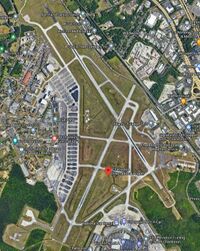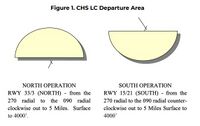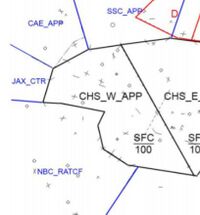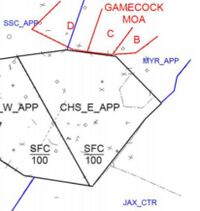Charleston AFB ATCT/TRACON: Difference between revisions
(→Ground) |
|||
| (10 intermediate revisions by the same user not shown) | |||
| Line 9: | Line 9: | ||
|A | |A | ||
|Updated of Page Organization/Movement and NON-Movement areas based on RW SOP/PDC Commands/Phraseology Examples | |Updated of Page Organization/Movement and NON-Movement areas based on RW SOP/PDC Commands/Phraseology Examples | ||
|- | |||
|6 June 2023 | |||
|B | |||
|Added PDC Authorized, Removal LOAs, Added LUAW Section, Organization | |||
|- | |||
|18 June 2023 | |||
|C | |||
|CHS_E_APP Frequency Change | |||
|} | |} | ||
| Line 66: | Line 74: | ||
|CHS_1_TWR | |CHS_1_TWR | ||
|8CT | |8CT | ||
| | |126.000 | ||
|} | |} | ||
</tab> | </tab> | ||
| Line 91: | Line 99: | ||
|CHS_1E_APP | |CHS_1E_APP | ||
|8ER | |8ER | ||
| | |121.275 | ||
|} | |} | ||
<span style='color:red;'>Sector in Red is the primary sector.</span> | <span style='color:red;'>Sector in Red is the primary sector.</span> | ||
| Line 190: | Line 198: | ||
The following areas are Non-Movement areas at CHS airport: Joint Base (JB) Charleston Ramp areas and taxiways leading up to the runway hold short lines. This includes all of Taxiway K, D, and E from the ramp to the Runway 15/33 hold short line, and taxiways D, H, F from the ramp to the Runway 3/21 hold short line. Fixed base Operators' designated ramp areas up to but not including taxiways G, G1, and G2. Charleston International Airport Terminal Ramp up to but no including taxiways B, taxiway M, and from the terminal ramp to the movement line on taxiway A.<br><br> | The following areas are Non-Movement areas at CHS airport: Joint Base (JB) Charleston Ramp areas and taxiways leading up to the runway hold short lines. This includes all of Taxiway K, D, and E from the ramp to the Runway 15/33 hold short line, and taxiways D, H, F from the ramp to the Runway 3/21 hold short line. Fixed base Operators' designated ramp areas up to but not including taxiways G, G1, and G2. Charleston International Airport Terminal Ramp up to but no including taxiways B, taxiway M, and from the terminal ramp to the movement line on taxiway A.<br><br> | ||
Aircraft shall be taxied to their location via the short distance. | Aircraft shall be taxied to their location via the short distance. | ||
===Transfer of Communication=== | ===Transfer of Communication=== | ||
Departing aircraft shall be instructed to contact the local control frequency upon or slightly before holding short the runway for departure. Local control has the option to have the pilot "monitor" the frequency. If a pilot is going to monitor, ground control must send a private message via the controller client of the aircraft with their callsign and runway. | Departing aircraft shall be instructed to contact the local control frequency upon or slightly before holding short the runway for departure. Local control has the option to have the pilot "monitor" the frequency. If a pilot is going to monitor, ground control must send a private message via the controller client of the aircraft with their callsign and runway. | ||
| Line 202: | Line 210: | ||
North Operations is designated as the calm wind runway.<br> | North Operations is designated as the calm wind runway.<br> | ||
<ul> | <ul> | ||
<li><b>North Ops:</b> Arriving: Runway 33 - Departing: Runway | <li><b>North Ops:</b> Arriving: Runway 3 and 33 - Departing: Runway 33</li> | ||
<li><b>South Ops:</b> Arriving: Runway 15 - Departing: Runway 21</li> | <li><b>South Ops:</b> Arriving: Runway 15 and 21 - Departing: Runway 21</li> | ||
</ul> | </ul> | ||
<br> | <br> | ||
| Line 210: | Line 218: | ||
<br> | <br> | ||
[https://www.faa.gov/air_traffic/publications/atpubs/atc_html/chap3_section_5.html 7110.65Z Runway Selection] | [https://www.faa.gov/air_traffic/publications/atpubs/atc_html/chap3_section_5.html 7110.65Z Runway Selection] | ||
=== Area of responsibility === | === Area of responsibility === | ||
LC is responsible for providing air traffic control services on all active runways. LC is also responsible for the CHS Local Control Departure Area.<br> | LC is responsible for providing air traffic control services on all active runways. LC is also responsible for the CHS Local Control Departure Area.<br> | ||
[[File:CHS_LC.JPG|200px|thumb|left|Local Control Control Departure Area]] | [[File:CHS_LC.JPG|200px|thumb|left|Local Control Control Departure Area]]<br><BR><BR><BR><BR><BR><BR><BR><BR> | ||
=== Arrival Procedures === | === Arrival Procedures === | ||
| Line 256: | Line 265: | ||
== [[TRACON Information]] == | == [[TRACON Information]] == | ||
=== TRACON Airspaces === | |||
<tabs> | <tabs> | ||
<tab name="CHS_W_APP"> | <tab name="CHS_W_APP"> | ||
| Line 286: | Line 296: | ||
|} | |} | ||
</tab> | </tab> | ||
< | </tabs> | ||
=== Arrival Procedures-General === | |||
The sector responsible for the primary runway shall establish the approach sequence for all arrivals.<br> | |||
Communications transfer of arriving aircraft to LC must be accomplished no later than five nautical miles from the end of the arrival runway.<br> | |||
When vectoring to final from parallel downwinds, aircraft on opposing base legs shall be assigned altitudes to ensure vertical separation unless other approved separation has been applied. This ensures separation in the event of an overshoot on final.<br> | |||
Coordinate with LC for any aircraft conducting approaches to other runways than the active arrival runway(s) in use. | |||
=== Departure Procedures-General === | |||
Forward departure instructions to LC for aircraft executing practice missed approaches.<br> | |||
Ensure all departures are on course as soon as practical.<br> | |||
All departures should be on course before handoff to Enroute Control unless otherwise coordinated. Aircraft shall be climbed to 10,000 or less if filed.<br> | |||
Provide airspace for automatic departures and radar final.<br> | |||
Provide airspace for missed approach on all runways.<br><br> | |||
<span style='color:red;'>Note: CHS TRACON Ensure notification ZJX AND MYR TRACON if Gamecock Charlie MOA or ROBROY airspace are hot/active.</span> | |||
=== Handoff and Radar Tracking === | |||
Charleston ATCT is a VFR tower. No radar handoffs shall be initiated to LC.<br> | |||
TRACON controllers shall not drop the track on any arriving aircraft. This allows a controller to maintain radar identification during missed approach. | |||
=== Release and Rolling Calls === | |||
TRACON sectors give automatic releases to all departures from Colubia ATCT when departures follow the standard departure procedures as specified in this document.<br> | |||
All other airports within TRACON’s boundaries shall request a departure release. Upon approval of the release, the release shall be good for five minutes.<br> | |||
Upon issuance of the takeoff clearance, a departure message shall be sent to the appropriate departure sector. This can be accomplished non-verbally by the LC ensuring the aircraft is squawking the appropriate squawk code and mode C is enabled when airborne. <br><br> | |||
=== VFR Aircraft within TRACON === | |||
VFR Aircraft entering the Class Charlie airspace will be given a discrete beacon code.<br> | VFR Aircraft entering the Class Charlie airspace will be given a discrete beacon code.<br> | ||
If an aircraft departs from CHS and does not request a flight following, the aircraft will be handed off from LC to TRACON and released to UNICOM once clear of the Class Charlie.<br> | If an aircraft departs from CHS and does not request a flight following, the aircraft will be handed off from LC to TRACON and released to UNICOM once clear of the Class Charlie.<br> | ||
<br> | <br> | ||
| Line 295: | Line 323: | ||
<span style='color:green;'><b>{Callsign}</b>, Change to Advisory Frequency Approved, squawk 1200.</span><br> | <span style='color:green;'><b>{Callsign}</b>, Change to Advisory Frequency Approved, squawk 1200.</span><br> | ||
[https://www.faa.gov/air_traffic/publications/atpubs/atc_html/chap7_section_8.html 7110.65Z Class C Service- Terminal] | [https://www.faa.gov/air_traffic/publications/atpubs/atc_html/chap7_section_8.html 7110.65Z Class C Service- Terminal] | ||
Latest revision as of 19:13, 7 February 2024
Table of Updates
| Date | Revision | Items Revised |
|---|---|---|
| 4 May 2023 | A | Updated of Page Organization/Movement and NON-Movement areas based on RW SOP/PDC Commands/Phraseology Examples |
| 6 June 2023 | B | Added PDC Authorized, Removal LOAs, Added LUAW Section, Organization |
| 18 June 2023 | C | CHS_E_APP Frequency Change |
Area Information
| ICAO Code | Airport Name | Airspace | IFR Beacon Codes | VFR Beacon Codes |
|---|---|---|---|---|
| KCHS | Charleston Air Force Base/International Airport | C | 7301-7337 | 7301-7337 |
| Purpose This document prescribes the procedures to be utilized for providing air traffic control services at the Charleston AFB Air Traffic Control Tower (CHS ATCT) and TRACON. The procedures described herein are supplemental to the Jacksonville ARTCC Facility Operating Guidelines and FAA Order JO 7110.65, as well as any published FAA guidelines or procedures. Distribution |
Operational Positions
| Position | Radio Name | Callsign | Relief Callsign | Symbol | Frequency |
|---|---|---|---|---|---|
| Clearance Delivery | Charleston Clearance Delivery | CHS_DEL | CHS_1_DEL | 8CD | 127.325 |
| Ground | Charleston Ground | CHS_GND | CHS_1_GND | 8CG | 121.900 |
| Tower | Charleston Tower | CHS_TWR | CHS_1_TWR | 8CT | 126.000 |
| Position | Sector Name | Callsign | Relief Callsign | Symbol | Frequency |
|---|---|---|---|---|---|
| WR | Radar West | CHS_W_APP | CHS_1W_APP | 8WR | 120.700 |
| RF | Radar East | CHS_E_APP | CHS_1E_APP | 8ER | 121.275 |
Sector in Red is the primary sector.
Clearance Delivery
Clearance Delivery Responsibilities
The Clearance Delivery Controller Must:
- Formulate and issue all IFR clearances to aircraft departing this field.
- Review proposed flight plan information for accuracy and amend routings and altitudes, as necessary, in accordance with this SOP.
- Enter amendments to flight plans into the controller client as required and advise the pilot what those amendments are.
- Issue clearances or route changes to aircraft, as required complying with traffic management initiatives and/or weather avoidance.
- Forward and await a response on all non-standard routing requests to the affected facilities.
- During Events: Do not change routes or proposal times for aircraft participating in Traffic Management programs without prior coordination with the controller in charge.
Pre-Departure Clearances
It is advisable that ALL controllers issue PDCs for departures for KCHS AFB ATCT
PDC Commands
If Charleston Approach or Jacksonville Center is Online: .pdcc {Departure Runway} {Dep Frequency ID}
If Charleston Approach and Jacksonville Center is Offline: .pdccu {Departure Runway}
IFR Departures
Planned/Amended Routing
All Aircraft shall be "cleared as filed unless a route amendment is necessary.
- LGRHD= Loggerhead
- MLTRE= Mull Tree
- PLMTO= Palmetto
- STUNO= Stuno
- SWPFX= Swampfox
Aircraft unable to accept an RNAV departure shall be cleared via radar vectors first filled/Cleared fix.
Assigned Altitudes
Aircraft shall be instructed to maintain 4,000 feet and to expect their cruise altitude (if higher) ten minutes after departure.
All IFR Aircraft conducting practice approaches shall maintain 2,000 feet
Departure Frequency
The Primary Departure Frequency is CHS_W_APP on 120.700.
Squawk Assignment
All IFR Squawk codes will be auto-assigned by the controller client.
It should assign a code between 7301-7337. Controllers shall not change the auto-assigned code if a code between 1601-1677 is not assigned.
VFR Departures
Clearance
VFR Aircraft do not need explicit clearance to enter or exit the airspace.
All VFR remaining in the pattern will require coordination with the tower and will be directed to contact when ready for taxi.
Assigned Altitudes
Jet: VFR aircraft shall be instructed to maintain VFR at or below 3,500.
Turboprops: VFR aircraft shall be instructed to maintain VFR at or below 3,500.
Props: VFR aircraft shall be instructed to maintain VFR at or below 3,500.
Departure Frequency
Aircraft not remaining in the pattern shall be given the Departure Frequency is CHS_W_APP on 120.700..
Aircraft remaining in the pattern shall not be given a departure frequency.
Squawk Assignment
VFR Squawk codes shall be assigned by the controller client using the assign squawk feature in their controller client.
Ground
General Information
Ground Control Responsibilities
The Ground Controller is responsible for the movement of vehicles and aircraft on the airport movement areas except for the active runway(s)
ATIS
Ground control shall confirm all pilots have the current ATIS code PRIOR to commencing taxi to the active runway. This can be achieved by requesting the pilot "state the current ATIS code". The ATIS is the responsibility of the tower controller.
Active Runway Operations
Except for runway crossings, Ground Control must transfer communication to Local Control if a vehicle/aircraft is to operate on a runway. Coordination for all runway crossings must be accomplished by requesting permission from local control by stating "(Number of Aircraft) to cross Runway (#) at Taxiway (Letter). Once approved and crossing has been granted and the crossing has been observed, ground control must state to local control "Runway (#) crossing complete"
Intersection Departures
Ground Control must advise local control of all intersection departures verbally.
Opposite Direction Departures
Ground Control must coordinate and obtain approval from Local Control, prior to taxiing an aircraft to a runway for an opposite-direction departure.
Pushback and Startup
Push back into a controlled area: Aircraft shall be instructed: "Push and Start Approved, tail facing (direction)." The direction should keep the aircraft pointed in the direction the aircraft will taxi.
Push back will not enter a controlled area: Aircraft shall be instructed: "Push and start at pilot's discretion."
Runway Assignments
The runway assignment should be the runway closest to the position of the aircraft based on the Active Runway Assignments as selected by the Local Controller.
Taxi Operations
The following areas are Non-Movement areas at CHS airport: Joint Base (JB) Charleston Ramp areas and taxiways leading up to the runway hold short lines. This includes all of Taxiway K, D, and E from the ramp to the Runway 15/33 hold short line, and taxiways D, H, F from the ramp to the Runway 3/21 hold short line. Fixed base Operators' designated ramp areas up to but not including taxiways G, G1, and G2. Charleston International Airport Terminal Ramp up to but no including taxiways B, taxiway M, and from the terminal ramp to the movement line on taxiway A.
Aircraft shall be taxied to their location via the short distance.
Transfer of Communication
Departing aircraft shall be instructed to contact the local control frequency upon or slightly before holding short the runway for departure. Local control has the option to have the pilot "monitor" the frequency. If a pilot is going to monitor, ground control must send a private message via the controller client of the aircraft with their callsign and runway. </tab> </tabs>
Tower
Active Runway Selection
The active runway shall be determined based on wind and known
factors that may affect the safety of takeoff/landing operations.
North Operations is designated as the calm wind runway.
- North Ops: Arriving: Runway 3 and 33 - Departing: Runway 33
- South Ops: Arriving: Runway 15 and 21 - Departing: Runway 21
Occasionally, operational factors may require a shift to Runway 15 and 3 or Runway 33 and 21. These are non-standard configurations and must be coordinated with TRACON. Automatic Releases are cancelled. Departures must be assigned runway heading and 2,000 feet.
7110.65Z Runway Selection
Area of responsibility
LC is responsible for providing air traffic control services on all active runways. LC is also responsible for the CHS Local Control Departure Area.
Arrival Procedures
LC shall be responsible for separation of all arrival aircraft that have
been handed off by TRACON from all departing aircraft still under LC
jurisdiction
Practice Instrument Approaches: Issue special instructions as verbally coordinated with the
TRACON. Practice Instrument Approaches shall assign runway heading and maintain 2,000 feet. Departure frequency as assigned by approach control.
LC shall NOT change the approach sequence without coordination. Communication transfer must be completed prior to five nautical miles
from the runway.
Automatic Terminal Information Service
LC shall manage the ATIS
The ATIS shall be on 124.750
Automatic Releases
LC is authorized automatic releases from the TRACON controller so long as the aircraft departs on the pre-coordinated active departing runway(s) on approved departure headings
In order for automatic releases to be authorized, procedures in this document shall be followed.
Departure releases must be obtained if automatic releases are suspended by TRACON.
Departure Procedures
LC will provide separation for aircraft in the LC airspace.
LC shall provide initial radar separation between successive departures.
When automatic departures are in effect, IFR jet/turbojet departures
shall be released on the RNAV SID for all RNAV departures or fanned heading for NON-RNAV Departures climbing to 4,000 feet.
Go Around/ Unplanned Missed Approaches
LC shall assign IFR aircraft runway heading and 2,000 feet
LC must verbally coordinate with departure prior to frequency change.
Land and Hold Short
LAHSO operations are authorized at CHS. During LAHSO Operations, if requested by the pilot, issue the following available distances for CHS:
- Runway 15, available landing distance 5,700 feet.
- Runway 33, available landing distance 2,900 feet.
- Runway 3, available landing distance 5,500 feet.
Line Up and Wait
Line up and wait is authorized at this field only in VMC Conditions. LUAW departures from an intersection are only authorized between sunrise and sunset.
Visual Tower
Charleston ATCT is a visual/VFR tower and shall not initiate or accept any radar handoffs and shall not initiate control/start track on any target.
TRACON Information
TRACON Airspaces
| WR (CHS_W_APP) is the primary "combined" radar position for Charleston Tracon. No other sectors shall be staffed until the "combined" position is in use. WR may delegate a portion of its airspace to ER.
|
| ER (CHS_E_APP) is the secondary radar position for Charleston Tracon. WR may delegate a portion of its airspace to ER.
|
Arrival Procedures-General
The sector responsible for the primary runway shall establish the approach sequence for all arrivals.
Communications transfer of arriving aircraft to LC must be accomplished no later than five nautical miles from the end of the arrival runway.
When vectoring to final from parallel downwinds, aircraft on opposing base legs shall be assigned altitudes to ensure vertical separation unless other approved separation has been applied. This ensures separation in the event of an overshoot on final.
Coordinate with LC for any aircraft conducting approaches to other runways than the active arrival runway(s) in use.
Departure Procedures-General
Forward departure instructions to LC for aircraft executing practice missed approaches.
Ensure all departures are on course as soon as practical.
All departures should be on course before handoff to Enroute Control unless otherwise coordinated. Aircraft shall be climbed to 10,000 or less if filed.
Provide airspace for automatic departures and radar final.
Provide airspace for missed approach on all runways.
Note: CHS TRACON Ensure notification ZJX AND MYR TRACON if Gamecock Charlie MOA or ROBROY airspace are hot/active.
Handoff and Radar Tracking
Charleston ATCT is a VFR tower. No radar handoffs shall be initiated to LC.
TRACON controllers shall not drop the track on any arriving aircraft. This allows a controller to maintain radar identification during missed approach.
Release and Rolling Calls
TRACON sectors give automatic releases to all departures from Colubia ATCT when departures follow the standard departure procedures as specified in this document.
All other airports within TRACON’s boundaries shall request a departure release. Upon approval of the release, the release shall be good for five minutes.
Upon issuance of the takeoff clearance, a departure message shall be sent to the appropriate departure sector. This can be accomplished non-verbally by the LC ensuring the aircraft is squawking the appropriate squawk code and mode C is enabled when airborne.
VFR Aircraft within TRACON
VFR Aircraft entering the Class Charlie airspace will be given a discrete beacon code.
If an aircraft departs from CHS and does not request a flight following, the aircraft will be handed off from LC to TRACON and released to UNICOM once clear of the Class Charlie.
Phraseology
{Callsign}, Change to Advisory Frequency Approved, squawk 1200.
7110.65Z Class C Service- Terminal



